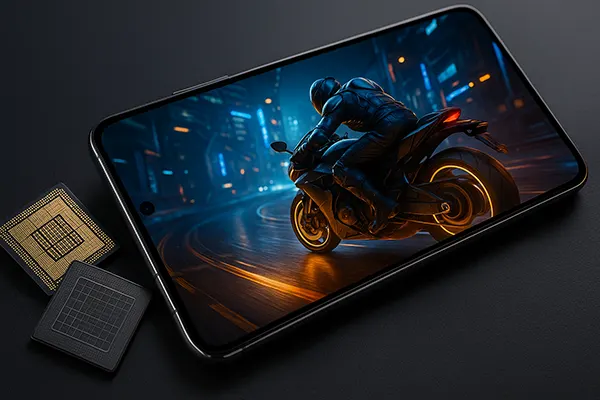
Android gaming in 2025: How Snapdragon 8 Gen 4 and Dimensity 9400 Are Transforming Mobile Gaming
The landscape of mobile gaming is undergoing a seismic shift in 2025. Thanks to the arrival of Qualcomm’s Snapdragon 8 Gen 4 and MediaTek’s Dimensity 9400, Android devices are now performing on par with some gaming laptops. These processors introduce cutting-edge architecture, immense AI integration, and unprecedented graphics capabilities, redefining what is possible in mobile gaming.
Breakthroughs in Mobile Processor Technology
Both Snapdragon 8 Gen 4 and Dimensity 9400 are built using advanced 3nm process nodes, allowing for higher transistor density and lower power consumption. The Snapdragon 8 Gen 4 is the first to feature Qualcomm’s custom Oryon CPU cores, which promise a performance leap of over 30% compared to its predecessor. Similarly, Dimensity 9400 utilises Arm’s latest Cortex-X5 core combined with four Cortex-A720 and four Cortex-A520 cores, delivering highly efficient multithreaded performance.
These chips are engineered to support gaming at 144Hz refresh rates, ray tracing, and ultra-low latency connectivity via Wi-Fi 7. Their integrated GPUs—the Adreno X1 for Snapdragon and Mali-G720 Immortalis for Dimensity—support Vulkan 1.3, OpenGL ES 3.2, and hardware-level ray tracing, enabling console-like visuals on Android devices.
Importantly, both chipsets offer dynamic thermal management through AI-based workload balancing. This ensures sustained performance during extended gaming sessions without significant heating issues, something that has long plagued high-end mobile gaming.
Performance Gains for Real-Time Gaming
The leap in processing power translates directly to real-world benefits for Android gamers. Games such as “Call of Duty: Warzone Mobile” and “Genshin Impact” now run at full settings with stable frame rates exceeding 90 FPS. Load times are reduced by up to 45%, and multitasking between games and background apps has become frictionless.
Developers are also capitalising on these advancements, integrating more detailed textures, enhanced AI behaviour, and real-time lighting effects. Gaming engines like Unreal Engine 5 and Unity are now fully optimised for these chipsets, allowing for more expansive game environments and complex physics interactions.
With support for LPDDR5X RAM up to 9600 Mbps and UFS 4.0 storage, the overall system responsiveness has improved substantially. This enables seamless game downloads, installations, and loading transitions, enhancing the overall user experience.
Artificial Intelligence and Adaptive Gaming
AI is at the heart of both Snapdragon 8 Gen 4 and Dimensity 9400. Qualcomm’s Hexagon NPU and MediaTek’s APU 790 are capable of over 60 TOPS (trillions of operations per second), supporting advanced AI-driven features in gaming. These include scene-based frame rate adaptation, smart battery usage prediction, and dynamic resolution scaling based on gameplay intensity.
AI also assists in voice recognition, gesture tracking, and motion prediction for AR/VR gaming. For example, Snapdragon’s AI stack enhances haptic feedback in supported games, simulating terrain textures or recoil through vibration in real time. Dimensity’s AI Scene Detection works to enhance visual fidelity without sacrificing frame rates, especially useful in GPU-heavy titles.
Moreover, AI-driven cooling algorithms now proactively adjust processing clusters and GPU loads based on predictive analysis of gaming behaviour, keeping thermal throttling at bay and maintaining high performance over longer durations.
Game Streaming and Cloud Integration
Another key evolution is the native support for low-latency cloud gaming through 5G and Wi-Fi 7. The new SoCs include enhanced modems with dual-SIM 5G standalone support and Wi-Fi 7 multi-link capabilities. This dramatically reduces ping times, which is critical for multiplayer and streaming-based experiences.
Partnerships with services like NVIDIA GeForce NOW, Xbox Cloud Gaming, and Google Play Games on PC are now fully integrated into flagship Android gaming phones. The Snapdragon Seamless and Dimensity Edge SDKs enable consistent device switching and syncing, letting gamers start a game on mobile and continue on PC or smart TV with no data loss.
These improvements foster a more interconnected ecosystem where high-performance Android devices serve as both local game stations and cloud game clients, maximising gameplay flexibility and mobility.

Implications for Game Developers and the Android Market
The launch of these powerful chipsets is reshaping the Android gaming ecosystem. Game developers are no longer constrained by mobile hardware limitations and can now design AAA experiences tailored specifically for Android. Titles like “Project Aurora” and “Assassin’s Creed Jade” have already been announced with exclusive support for devices equipped with Snapdragon 8 Gen 4 or Dimensity 9400.
This shift also affects market segmentation. Premium-tier smartphones are being marketed explicitly as gaming devices, complete with advanced cooling systems, trigger buttons, and AMOLED displays with up to 300Hz touch sampling. Brands like ASUS ROG, RedMagic, and Lenovo Legion are leading this wave in 2025.
Additionally, mid-range smartphones featuring slightly downscaled versions of these chipsets (Snapdragon 8s Gen 3 and Dimensity 8300) still offer robust gaming performance, making advanced features more accessible to the broader audience.
Outlook and Industry Trends
As we move through 2025, expectations for mobile gaming will continue to evolve. Developers are already testing native support for 8K resolution assets and real-time AI-powered NPC interactions. The continuous enhancement of chip-level AI and GPU rendering pipelines will allow for richer storytelling and immersive gameplay mechanics.
Security features embedded in both processors, including real-time fraud detection and secure DRM, are improving in-app purchase integrity and safeguarding user data. This is particularly vital in competitive and esports gaming environments.
In summary, Snapdragon 8 Gen 4 and Dimensity 9400 represent more than just technical upgrades—they are catalysts accelerating the convergence between mobile and traditional gaming platforms. Android gaming is no longer catching up. In 2025, it’s setting the pace.



